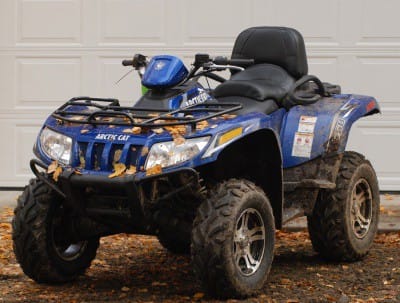
With the average wheeler totaling nine grand for a 500cc class machine, we know that driving around the dealer’s parking lot just won’t cut it when you’re ready to buy.
To help you decide which quad is worth your hard earned coin, I compared two North American Built ATV’s; an Arctic Cat TRV GT and Can-Am’s Outlander Max XT. Both have added “two-up” rear passenger seats making these machines an alternative to side-by-sides that may not fit into your riding style.
My proving ground was Alaska, out my back door on a tight, hilly, root-strung trail selected for narrow tree passages, steep short hills, and steering punishing fallen timber. An open stretch of gravel road was added to play the power curve and evaluate high-speed handling.
The two bikes each featured power steering and were pushed by up to a 550cc engine. Both units were plush, had electronic fuel injection, and independent rear suspensions.
Arctic Cat 550i H1 EFI TRV GT/Built in USA
Gaining acceptance as an alternative to side by sides, Arctic Cat was the second North American manufacturer to adopt a two-man seating system (Can-Am was first)on a traditional ATV. Powered by Cat’s own EFI motor, the longer chassis is supported by a sensitive suspension and speed-sensing power steering. Other riding features include underside suspension guards, a two-inch receiver, and a fold-up rear rack.
Even with the longer wheelbase, I enjoyed the trail performance of the two-up machine and found it highly capable in jagged terrain. The on-demand lock, 4-wheel switch, and the stable, assuring ride were welcomed additions. The power was responsive, and the brakes had a firm feel even with additional human cargo. The shifting handle was significantly smoother than the BRP.
A few issues crept up with the Cat, including increased noise levels at high speeds, and a wider than expected turning radius. I also found the steering was not forgiving when over corrected.

Specs:
Dry Weight: 764 lbs.
Suspension Travel (front/rear): 10″/10″
Transmission: Automatic CVT with EBS
Engine: SOHC, 4-stroke, 4-valve w/EFI liquid cool
Displacement: 545cc
Fuel Capacity: 5.3 gal
Price: $9,799
Can-Am Outlander Max 500 XT/Built in Canada
This stretched wheeler from Can-Am has the only 40.4-hp v-twin in the category. The bike uses a three setting programmable power steering system. An abundance of extras include an auto lock differential, wind stopping handlebar covers, and the passenger seat sits slightly forward of the rear axle. The system converts to a single rider by replacing the passenger seat with a toolbox.
I felt the two-up seating position with lumbar support offered more passenger comfort than the Arctic Cat. Impressive torque and braking were also the rule. The Visco auto lock system operated flawlessly when climbing over trail logs. The ride was balanced and extremely comfortable.
It takes a bigger bike to carry two, and size was an issue due to the wider steering radius.

Specs:
Dry Weight: 704 lbs.
Suspension Travel (front/rear): 7″/9″
Transmission: CTV w/engine braking
Engine: V-twin, liquid-cooled, SOHC, 8-valve (4-valve/cyl)
Displacement: 499.6cc
Fuel Capacity: 4.3 gal
Price: $10,149. (Camo not included)
Head to Head
Although the Cam Am was noisier, both 4-wheelers were equally susceptible to mud holes. Anytime you increase the length of a frame, even with impressive suspension modifications, there are going to be trade-offs. Also in this test, the turning radius was equally compromised on both bikes. A winch is a must for either ATV.
The Can Am suspension felt slightly better with a passenger on board, but the Cat was a little more comfortable at high speeds, and overall I would say the Cat had more torque. From an historical perspective, the Cam Am’s Rotax engine has an excellent reputation for long-term durability. Although Arctic Cat’s fairly new US made power plant has impressive performance, it just hasn’t been in the market long enough to judge. That said, there is no reason to think it would not perform equally well in the long haul.
These “two-up” quads are not the same animal as a side-by-side. Given that distinction, if you’re traveling narrow trails and don’t need a dump bed, they are both highly comfortable alternatives.
Comparing the two head to head based on power and quiet, I would give my slight nod to the Arctic Cat.
The Union Sportsmen’s Alliance website is designed to provide valuable articles about hunting, fishing and conservation for members of AFL-CIO affiliated labor unions and all sportsmen and sportswomen who appreciate hunting and fishing and want to preserve our outdoor heritage for future generations. If you would like your own story and experience from the outdoors to be considered for our website, please email us at[email protected].






